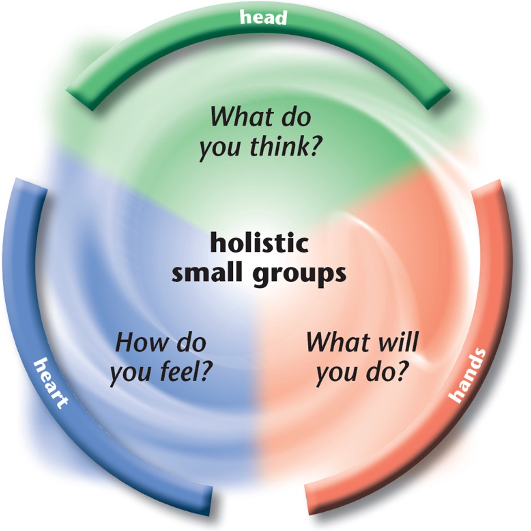Establishing Christian Community
Mary Ellen and Kate try to get together once a month a for coffee. They use their time to catch up on each other’s lives and share in each other’s struggles. They always end their time by praying together.
 Three families from the Your Town Christian Church get together every Wednesday night for Bible study. They show up at the church each week at 6:00 and promptly end at 7:00. When asked why they meet together, they share they do so because “that’s what ‘good Christians’ do.â€
 Mathias heads up a group for young adults in his church that meets once a month. The group has a short devotional, then plays games together–board games in the winter and outside games in the summer. Afterwards, many of the group go out to the local Dairy Queen for a treat.
When you consider these three scenarios, which of them do you think represents a Christian community? Would it surprise you to find out that the coffee get-together and monthly youth night were closer to the spirit of biblical community than the Bible study?
Defining Community
The Bible tells us in Matthew 18:20 that, “where two or three are gathered in my name, there am I among them.†That means that when a group of people intentionally get together to experience God’s presence and invest in each other, community is “happening.†Any occasion for interaction can provide space for intentional relationship-building (that is, the development of trust, care, support, etc.) and is a place where God’s presence can be experienced.
Because of this, community may look different than what you have previously thought. Community might occur by:
- Calling a friend to let them know you are praying for them;
- Playing soccer or football with a group of friends;
- Going for a run with a couple of friends on a weeknight;
- Getting a cup of coffee or enjoying an ice cream cone with a friend;
- Serving on the church board;
- Singing with your church’s choir; or
- Sharing a meal together after church.
Now, if you are struggling with the idea that the Bible study may not necessarily represent a “Christian community,†and is not holistic in its nature, let me clarify: this particular study did not exemplify community because the mindset of the group members was wrong. Bible studies are a great place to foster Christian community, but a mindset focused on tasks alone kills community. If people are not investing in each other, digging into the hard parts of life together, authentically sharing their own joys and sorrows, and encouraging each other in the Lord, community (as presented in the Bible) does not and cannot occur.
Holistic Small Groups
If you have been around NCD for much time at all, you will know that one of the eight quality characteristics upon which church health is built is “holistic small groups.†But what does that actually mean? Simply put, holistic small groups allow us to express our love to God in three ways: with our heads, our hands, and our hearts (see diagram below). There are three basic questions we must ask:
- What do you think (head)?
- How do you feel (heart)?
- What will you do (hands)?

Additionally, there are seven qualities that take a position in relation to each area (heads, hands, hearts).

- Effective structures (green/head) are focused on reflective through and consistent planning.
- Need-oriented evangelism (red/hands) focuses on doing something practical, often manifesting itself through sharing what we have received.
- Passionate spiritualty (blue/heart) includes every aspect of our emotional lives.
- Gift-based ministry is positioned between head (green) and hands (red) as it relates to spiritual gifts to concrete tasks.
- Loving relationships is between heart (blue) and hands (red); it involves doing the right thing for the right reason.
- Inspiring worship is positioned between the head (green) and heart (blue) and is less action-focused, but more focused on internal processing between the head and heart.
- At the center of this all is empowering leadership, which utilizes characteristics of all three color-areas, depending on the need of the group.
Small groups are, in essence, miniature churches. And, just as churches have different focuses in their mission, small groups do the same. Some small groups focus on nurturing a person and his/her relationship with Jesus. Others focus on outreach and/or ministering to others. Christian Schwarz even suggests that, “Differences in focus at the small group level is one of the greatest resources of a local church†(Schwarz, 2012, p. 14). What powerful potential small groups have!
Consider your own experiences with Christian community. Have you been involved in true community, or have you simply by ticking off the box by doing “what good Christians do?†If you desire to engage in authentic Christian community, how can you take concrete steps to ensure that happens?
Across the next few blogs, we will be examining different facets of Christian community. We hope and pray that you will come along on this journey with us and commit to make changes in areas where you may currently struggle. The path may be arduous, but the destination is well-worth the struggle.
Want to Learn More?
- What kind of research has NCD International done on small groups?
- Why are the quality characteristics of healthy churches and small groups almost identical?
To get answers to these questions and more, visit 3colorsofcommunity.org.
Reference
Schwarz, C. A. (2012). The 3 colors of community. St. Charles, IL: ChurchSmart Resources.

